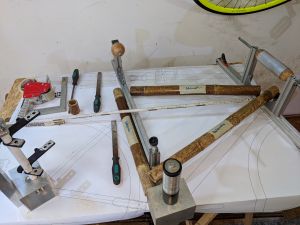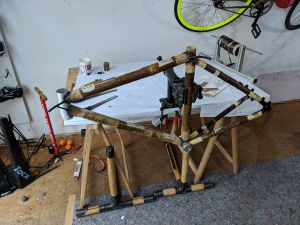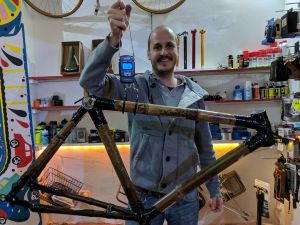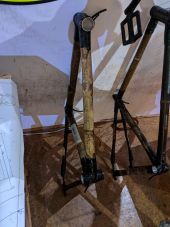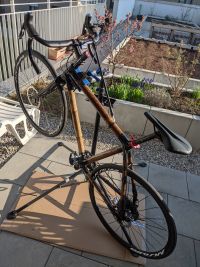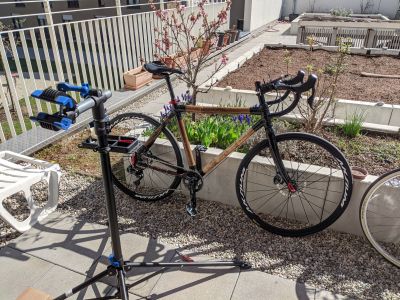BambooBike
| Bamboo road bicycle Release status: beta [box doku] | |
|---|---|
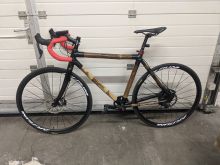
| |
| Description | Manufacturing a bamboo bicycle frame and buildup of the corresponding road bike. |
| Author(s) | Uli (Uli) |
| Last Version | 1.0.0 (03.08.2020) |
Introduction
I always dreamt of a bamboo bicycle because most of them look beautiful and some of them even are tough racing machines. I even thought that bamboo bikes are pretty lightweight, but learned that they are in fact not lighter than most mid-range priced aluminum frames, but I got to find out by myself. As a birthday present, I got to participate in a weekend workshop to build my own individual bamboo bicycle frame. It was a lot of work to build the frame, but the bicycle project had just begun...
Before the workshop
- frame type (road)
- measures (individual)
- material (select bamboo color and type -> tiger bamboo is more lightweight)
- features (derailleur gears, disc brakes, black anodized aluminum dropouts, internal cable channels)
Bamboo bicycle frame workshop
- full weekend of work (plus some extra hours for polishing)
* saw bamboo parts and glue them to the headtube, bottom bracket and the dropouts * use reams of layers of epoxy resin and carbon fibre to solidly fix the parts altogether * let harden over several nights * sand the whole frame and give it a glossy epoxy coat finish against humidity
Build up bike
- get familiar with bike parts and quasi standards
- order parts
- special tools and handicraft work
Bill of materials (english translation will follow)
- Steuersatz
- Sattel
- Sattelstütze
- Schnellspanner
- Gabel
- Radsatz
- Schnellspanner für Hohlachsen
- Bremsscheiben
- Lenker
- Lenkerband
- STI (Integrierte Brems- und Schalthebel)
- Kabel
- Kabel-Verteiler
- Steuereinheit
- Tretlager Pressfit BB-92
- Kurbel
- Kette
- Kettenblatt
- Kassette
- Schaltwerk
- Pedale
Todo
- place battery into steering tube (ok)
* shorten steering tube (ok) * drill hole for cable outlet (ok) * paint steering tube black
- integrate derailleur cables into frame
* clip cable * put through frame * solder it back together with water proof insulation
- get rid of rattling noises
Learnings
- you do not always need professional tools - but if you have them, they are awesome
Conclusion
I am really proud of my completed bamboo bicycle project, because it turned out as I dreamed it to be or even better. On the other side incredible amounts of learning and research about bicycle parts, quasi-standards, the bicycle trade and crafting were involved because even though I was interested in bicycles, I had no idea what I did not know yet. In the end it was way more work to build up the bike than to build the frame, which I imagined to be much easier and less time consuming. Even though it was worth the effort for me, I would not recommend building up your bamboo bike on your own if you are not already an expert in the field or really interested in learning all that, because it can be really frustrating if you do not know where to start or when you start thinking that you need to buy special tools just to use them once.
